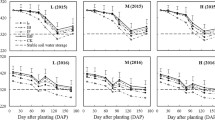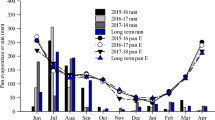Abstract
The ridge and furrow rainfall harvesting planting system (RFRHP) where runoff is collected by plastic mulched ridges can improve the crop productivity in the semiarid areas of northwest China. During 2012–2014, we performed a field evaluation of the influence of RFRHP with supplementary irrigation (RI) on the water irrigation use and water use efficiency by maize in a semiarid climate using the following treatments: (1) no supplementary irrigation (RN); (2) irrigation during the trumpeting stage (RB); (3) irrigation during the blooming stage (RF); (4) irrigation during the trumpeting and blooming stages (RBF); and (4) traditional flat planting with border irrigation (CK). We found that although the irrigation volume was double under CK, the soil water content in the 0–120 cm soil layer did not differ significantly between the RFRHP with supplementary irrigation treatments and CK. The RFRHP with supplementary irrigation treatments reduced the irrigation water volume required (750–1125 m3 hm−2) and alleviated drought stress during key maize growth periods. The biomass, grain yield, and water use efficiency were significantly higher under RFRHP with supplementary irrigation, i.e., 6.0–8.7%, 15.4–25.8%, and 34.9–39.2% higher compared with CK, respectively, and 3.8–6.4%, 4.8–14.2%, and 9.2–12.7% higher compared with RFRHP with no supplementary irrigation. Under RFRHP with supplementary irrigation treatments, the irrigation water use efficiency was 1.5–3.9 times higher than that under CK. The irrigation water productivity levels under the RFRHP with supplementary irrigation treatments were ranked as follows: trumpeting stage > trumpeting and blooming stages > blooming stage. Compared with CK, RFRHP with supplementary irrigation significantly increased the out/input ratio and net income by 13.1–26.9% and 2600–3762 Chinese Yuan hm−2, respectively.






Similar content being viewed by others
References
Albaji M, Shahnazari A, Behzad M, Naseri A, BoroomandNasab S, Golabi M (2010) Comparison of different irrigation methods based on the parametric evaluation approach in Dosalegh plain: Iran. Agric Water Manag 97:1093–1098. https://doi.org/10.1016/j.agwat.2010.02.015
Allen RG, Pereira LS, Raes D, Smith M (1998) Crop evapotranspiration guidelines for computing crop water requirements. (Irrigation and drainage paper 56) Food and Agriculture Organization of the United Nations, Rome
Boers TM, Zondervan K, Ben-Asher J (1986) Micro-catchment-water-harvesting (MCWH) for arid zone development. Agric Water Manag 12:21–39. https://doi.org/10.1016/j.agwat.2010.08.002
Chakraborty D, Nagarajan S, Aggarwal P, Gupta V, Tomar R, Garg R, Sahoo R, Sarkar A, Chopra UK, Sarma KS (2008) Effect of mulching on soil and plant water status, and the growth and yield of wheat (Triticum aestivum L.) in a semi-arid environment. Agric Water Manag 95:1323–1334. https://doi.org/10.1016/j.agwat.2008.06.001
Doorenbos J, Pruitt WO (1977) Guidelines for predicting crop water requirements. FAO irrigation and drainage paper no. 24. Food and Agriculture Organization of the United Nations, Rome
Du T, Kang S, Sun J, Zhang X, Zhang J (2010) An improved water use efficiency of cereals under temporal and spatial deficit irrigation in north China. Agric Water Manag 97:66–74. https://doi.org/10.1016/j.agwat.2009.08.011
FAO/UNESCO (1993) World soil resources. An explanatory note on the FAO world soil resource map at 1: 25,000,000 scales. Rome, FAO
Ferraro D, Ghersa C (2007) Quantifying the crop management influence on arable soil condition in the Inland Pampa (Argentina). Geoderma 141:43–52. https://doi.org/10.1016/j.geoderma.2007.04.025
Gan Y, Siddique KH, Turner NC, Li XG, Niu JY, Yang C, Liu L, Chai Q (2013) Ridge-furrow mulching systems-an innovative technique for boosting crop productivity in semiarid rain-fed environments. Adv Agron 118:429–476. https://doi.org/10.1016/B978-0-12-405942-9.00007-4
Geerts S, Raes D, Garcia M, Vacher J, Mamani R, Mendoza J, Huanca R, Morales B, Miranda R, Cusicanqui J, Taboada C (2008) Introducing deficit irrigation to stabilize yields of quinoa (Chenopodium quinoa Willd). Eur J Agron 28:427–436. https://doi.org/10.1016/j.eja.2007.11.008
Huang YL, Chen LD, Fu BJ, Huang ZL, Gong J (2005) The wheat yields and water-use efficiency in the Loess Plateau: straw mulch and irrigation effects. Agric Water Manag 72:209–222. https://doi.org/10.1016/j.agwat.2004.09.012
Jin K, Sleutel S, Buchan D, De Neve S, Cai DX, Gabriëls D, Jin JY (2009) Changes of soil enzyme activities under different tillage practices in the Chinese Loess Plateau. Soil Till Res 104:115–120. https://doi.org/10.1016/j.still.2009.02.004
Kang SZ, Su XL, Tong L, Shi P, Yang XY, Abe Y, Du TS, Shen QL, Zhang JH (2004) The impacts of human activities on the water–land environment of the Shiyang River basin, an arid region in northwest China. Hydrol Sci J 49:413–427. https://doi.org/10.1623/hysj.49.3.413.54347
Li FR, Zhao SL, Geballe GT (2000) Water use patterns and agronomic performance for some cropping systems with and without fallow crops in a semi-arid environment of northwest China. Agric Ecosyst Environ 79:129–142
Li XY, Gong JD, Gao QZ, Li FR (2001) Incorporation of ridge and furrow method of rainfall harvesting with mulching for crop production under semiarid conditions. Agric Water Manag 50:173–183. https://doi.org/10.1016/S0378-3774(01)00105-6
Li SE, Kang SZ, Li FS, Zhang L (2008) Evapotranspiration and crop coefficient of spring maize with plastic mulch using eddy covariance in northwest China. Agric Water Manag 95:1214–1222. https://doi.org/10.1016/j.agwat.2008.04.014
Li SZ, Wang Y, Fan TL, Wang LM, Zhao G, Tang XM, Dang Y, Wang GL, Zhang JJ (2010) Effects of different plastic film mulching modes on soil moisture, temperature and yield of dryland maize. Sci Agric Sin 43:922–931 (in Chinese with English abstract)
Li R, Hou XQ, Jia ZK, Han QF, Ren XL, Yang BP (2013) Effects on soil temperature, moisture, and maize yield of cultivation with ridge and furrow mulching in the rainfed area of the Loess Plateau, China. Agric Water Manag 116:101–109. https://doi.org/10.1016/j.agwat.2012.10.001
Liu WZ, Zhang XC (2007) Optimizing water and fertilizer input using an elasticity index: a case study with maize in the loess plateau of china. Field Crop Res 100:302–310. https://doi.org/10.1016/j.fcr.2006.08.005
Liu C, Jin S, Zhou L, Jia Y, Li F, Xiong Y, Li X (2009) Effects of plastic film mulch and tillage on maize productivity and soil parameters. Eur J Agron 31:241–249. https://doi.org/10.1016/j.eja.2009.08.004
Liu Y, Yang SJ, Li SQ, Chen XP, Chen F (2010) Growth and development of maize (Zea mays L.) in response to different field water management practices: resource capture and use efficiency. Agric Forest Meteorol 150:606–613. https://doi.org/10.1016/j.agrformet.2010.02.003
Liu HJ, Kang Y, Yao SM, Sun ZQ, Liu SP, Wang QG (2013) Field evaluation on water productivity of winter wheat under sprinkler or surface irrigation in the North China plain. Irrig Drain 62:37–49. https://doi.org/10.1002/ird.1712
Payero JO, Tarkalson DD, Irmak S, Davison D, Petersen JL (2008) Effect of irrigation amounts applied with subsurface drip irrigation on corn evapotranspiration, yield, water use efficiency, and dry matter production in a semiaridclimate. Agric Water Manag 95:895–908. https://doi.org/10.1016/j.agwat.2008.02.015
Raeini-Sarjaz M, Barthakur N (1997) Water use efficiency and total dry matter production of bush bean under plastic covers. Agric Forest Meteorol 87:75–84. https://doi.org/10.1016/S0168-1923(97)00007-5
Ramakrishna A, Tam HM, Wani SP, Long TD (2006) Effect of mulch on soil temperature, moisture, weed infestation and yield of groundnut in northern Vietnam. Field Crop Res 95:115–125. https://doi.org/10.1016/j.fcr.2005.01.030
Ren XL, Jia ZK, Chen XL (2008) Rainfall concentration for increasing corn production under semiarid climate. Agric Water Manag 95:1293–1302. https://doi.org/10.1016/j.agwat.2008.05.007
Ren XL, Chen XL, Jia ZK (2010) Effect of rainfall collecting with ridge and furrow on soil moisture and root growth of corn in semiarid northwest China. J Agron Crop Sci 196:109–122. https://doi.org/10.1111/j.1439-037X.2009.00401.x
Sun HY, Liu CM, Zhang XY, Shen YJ, Zhang YQ (2006) Effects of irrigation on water balance, yield and WUE of winter wheat in the North China Plain. Agric Water Manag 85:211–218. https://doi.org/10.1016/j.agwat.2006.04.008
Turner NC (1986) Crop water deficits: a decade of progress. Adv Agron 39:1–51
Turner NC, Li FM, Xiong YC, Siddique KH (2011) Agricultural ecosystem management in dry areas: challenges and solutions. Plant Soil 347:1–6. https://doi.org/10.1007/s11104-011-0949-x
Wang Q, Zhang E, Li FM, Li FR (2008) Runoff efficiency and the technique of micro-water harvesting with ridges and furrows, for potato production in semi-arid areas. Water Resour Manag 22:1431–1443. https://doi.org/10.1007/s11269-007-9235-3
Wang Y, Xie Z, Malhi SS, Vera CL, Zhang Y, Wang J (2009) Effects of rainfall harvesting and mulching technologies on water use efficiency and crop yield in the semi-arid Loess Plateau, China. Agric Water Manag 96:374–382. https://doi.org/10.1016/j.agwat.2008.09.012
Wang J, Gong S, Xu D, Yu Y, Zhao Y (2013) Impact of drip and level-basin irrigation on growth and yield of winter wheat in the North China Plain. Irrig Sci 31:1025–1037. https://doi.org/10.1007/s00271-012-0384-7
Wu PT, Feng H (2005) Discussion of the development strategy of water saving agriculture in China. Trans Chin Soc Agric Eng 21:152–157 (in Chinese with English abstract)
Wu Y, Jia ZK, Ren XL, Zhang Y, Chen X, Bing HY, Zhang P (2015) Effects of ridge and furrow rainwater harvesting system combined with irrigation on improving water use efficiency of maize (Zea mays L.) in semi-humid area of China. Agric Water Manag 158:1–9. https://doi.org/10.1016/j.agwat.2015.03.021
Zhang HP, Oweis T (1999) Water–yield relations and optimal irrigation scheduling of wheat in the Mediterranean region. Agric Water Manag 38:195–211. https://doi.org/10.1016/S0378-3774(98)00069-9
Zhang J, Sui X, Li B, Su B, Li J, Zhou D (1998) An improved water-use efficiency for winter wheat grown under reduced irrigation. Field Crop Res 59:91–98
Zhang Y, Kendy E, Qiang Y, Changming L, Yanjun S, Hongyong S (2004) Effect of soil water deficit on evapotranspiration, crop yield, and water use efficiency in the North China Plain. Agric Water Manag 64:107–122
Zhang SL, Lövdahl L, Grip H, Tong YA, Yang XY, Wang QJ (2009) Effects of mulching and catch cropping on soil temperature, soil moisture and wheat yield on the Loess Plateau of China. Soil Till Res 102:78–86. https://doi.org/10.1016/j.still.2008.07.019
Zhang Y, Han QF, Cheng XF, Yang SS, Jia ZK, Ding RX, Ren XL, Nie JF (2015) Effects of ridge and furrow rain harvesting with supplemental irrigation on winter wheat photosynthetic characteristics, yield and water use efficiency in Guanzhong irrigation district. Chin J Appl Ecol 26:1382–1390 (in Chinese with English abstract)
Zhou LM, Jin SL, Liu CA, Xiong YC, Si JT, Li XG, Gan YT, Li FM (2012) Ridge-furrow and plastic-mulching tillage enhances maize–soil interactions: opportunities and challenges in a semiarid agroecosystem. Field Crop Res 126:181–188. https://doi.org/10.1016/j.fcr.2011.10.010
Acknowledgements
This study was supported by the China Support Program (2015BAD22B02) for Dryland Farming in the 12th 5-year plan period, the National High-Tech Research and Development Programs of China (“863 Program”) for the 12th 5-Year Plans (2013AA102902), the National Natural Science Foundation of China (No. 31801314, 31571614, and 31400332), the Program of Introducing Talents of Discipline to Universities (No. B12007), and the Postdoctoral Science Foundation funded project (2016M602870, 2017BSHEDZZ140). We are also grateful to Wang Junpeng, Nie Junfeng, Yang Baoping and Ding Ruixia for help during experimental period.
Author information
Authors and Affiliations
Corresponding author
Additional information
Communicated by E. Fereres.
Publisher's Note
Springer Nature remains neutral with regard to jurisdictional claims in published maps and institutional affiliations.
Peng Zhang and Ting Wei contributed equally to this publication.
Rights and permissions
About this article
Cite this article
Zhang, P., Wei, T., Li, Y. et al. Effects of deficit irrigation combined with rainwater harvesting planting system on the water use efficiency and maize (Zea mays L.) yield in a semiarid area. Irrig Sci 37, 611–625 (2019). https://doi.org/10.1007/s00271-019-00628-4
Received:
Accepted:
Published:
Issue Date:
DOI: https://doi.org/10.1007/s00271-019-00628-4




